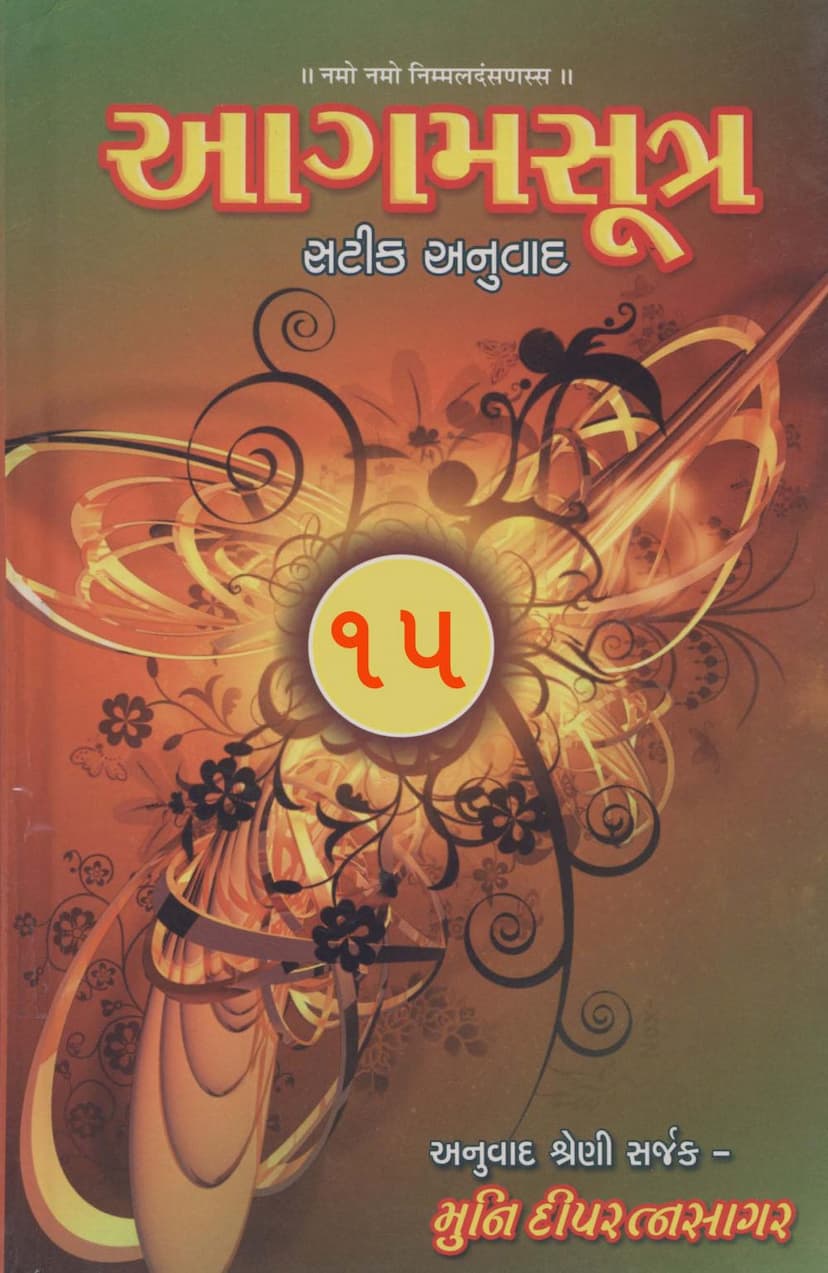Agam Satik Part 15 Upaasakdasha Aadi Sutro Gujarati Anuwad
Added to library: September 1, 2025

Summary
Here is a comprehensive summary in English of the Jain text "Agam Satik Part 15 Upaasakdasha Aadi Sutro Gujarati Anuwad":
This text, "Agam Satik Part 15," is the fifteenth volume in a series of "Agam Satik Anuwanad" (commented translations of Agamas) by Muni Deepratnasagar. This particular part focuses on four important Anga Sutras of Jainism:
-
Upaasakdasha (The Chapter on Lay Disciples): This is the seventh Anga Sutra. It contains ten chapters, primarily focusing on the Dharma Anuyoga (discourse on righteousness) and the lives of ten prominent lay disciples (Shravakas) named Anand, Kamdev, Chullani's Father, Suradev, Gulshatak, Kundakolik, Sadalaputra, Mahashatak, Nandini's Father, and Shaliki's Father. The text provides detailed narratives of their lives, spiritual practices, and eventual attainment of liberation or heavenly abodes, often illustrating the principles of Jain lay conduct through their experiences.
-
Antakridaasha (The Chapter on Those Who Attain Final Liberation): This is the eighth Anga Sutra. It is currently available in eight classes, containing a total of ninety chapters. These chapters primarily narrate the life stories and spiritual journeys of souls who, at the end of their lives, achieved Kevali (omniscience) and attained Siddhahood (final liberation). These stories highlight the rigorous spiritual practices and profound detachment necessary for ultimate liberation.
-
Anuttaraupapattikadasha (The Chapter on Those Born in the Highest Heavens): This is the ninth Anga Sutra. It contains three classes with a total of thirty-three chapters. These chapters narrate the life stories of thirty-three monks (Shramanas) who were born in the Anuttara heavens (the highest celestial realms), illustrating the fruits of exceptional spiritual merit and detachment leading to such sublime rebirths.
-
Prashnavyakaran (The Chapter on Questions and Answers): This is the tenth Anga Sutra. It is currently available in ten chapters. Five chapters are dedicated to the concept of Ashrava (influx of karma), detailing five types: Himsa (violence), Mrusha (falsehood), Adattadan (stealing), Abrahmacharya (unchastity), and Parigraha (possessions). The remaining five chapters discuss Samvara (cessation of karma), detailing the corresponding five types: Ahimsa (non-violence), Satya Vachan (truthful speech), Adattadan Viraman (abstinence from stealing), Brahmacharya (celibacy), and Aparigraha (non-possession). The text meticulously explains these concepts, their karmic consequences, and the practices to cultivate them.
Key Features and Content:
- Commented Translation: The text provides a Gujarati translation of the original Prakrit Agamas, along with extensive commentary (Tika) and explanations, making the profound teachings accessible to a wider audience.
- Illustrative Narratives: The lives of the Shravakas (lay disciples) and the Siddhas are narrated through stories and dialogues, offering practical examples of how Jain principles are applied in daily life and spiritual pursuit.
- Detailed Explanations: The commentary clarifies complex Jain philosophical concepts, such as the nature of Ashrava and Samvara, the principles of right conduct, and the path to liberation.
- Spiritual Guidance: The text serves as a guide for lay followers (Shravakas) and ascetics (Munis), outlining the essential virtues, vows, and practices for spiritual progress.
- Focus on Conduct: The Upaasakdasha, in particular, emphasizes the ethical conduct, vows, and spiritual attainments of lay disciples, showcasing their significant role in the Jain path.
- Path to Liberation: The Antakridaasha and Anuttaraupapattikadasha narratives exemplify the ultimate goals of Jainism – liberation from the cycle of birth and death – by showcasing individuals who achieved it through intense austerity and detachment.
- Philosophical Depth: The Prashnavyakaran delves into the nuances of karma, its influx (Ashrava), and its cessation (Samvara), providing a deeper understanding of the mechanisms of karmic bondage and liberation.
The translation and commentary aim to illuminate the original Agamas, facilitating a deeper study and practice of Jainism. The volume is presented with acknowledgments to various donors and supporters, highlighting the collaborative effort in bringing these sacred texts to the public.